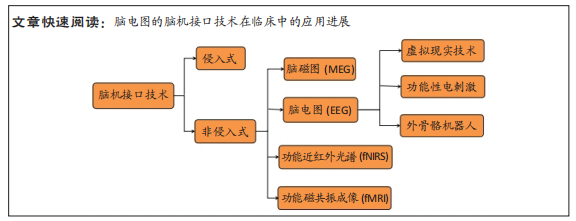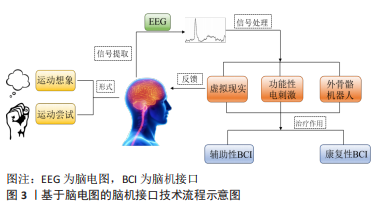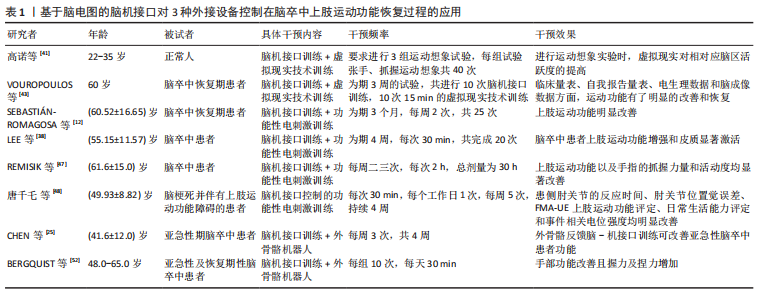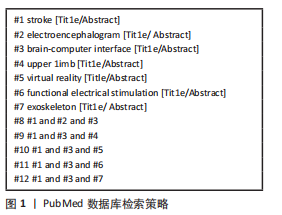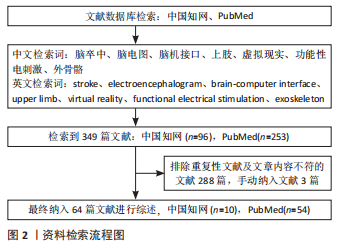[1] BENJAMIN EJ, VIRANI SS, CALLAWAY CW, et al. Heart Disease and Stroke Statistics-2018 Update: A Report From the American Heart Association. Circulation. 2018;137(12):e67-e492.
[2] COSCIA M, WESSEL MJ, CHAUDARY U, et al. Neurotechnology-aided interventions for upper limb motor rehabilitation in severe chronic stroke. Brain. 2019;142(8):2182-2197.
[3] LACKLAND DT, ROCCELLA EJ, DEUTSCH AF, et al. Factors influencing the decline in stroke mortality: a statement from the American Heart Association/American Stroke Association. Stroke. 2014;45(1):315-353.
[4] MADHOUN HY, TAN B, FENG Y, et al. Task-based mirror therapy enhances the upper limb motor function in subacute stroke patients: a randomized control trial. Eur J Phys Rehabil Med. 2020;56(3):265-271.
[5] DEHEM S, GILLIAUX M, STOQUART G, et al. Effectiveness of upper-limb robotic-assisted therapy in the early rehabilitation phase after stroke: A single-blind, randomised, controlled trial. Ann Phys Rehabil Med. 2019; 62(5):313-320.
[6] DERAKHSHANFAR M, RAJI P, BAGHERI H, et al. Sensory interventions on motor function, activities of daily living, and spasticity of the upper limb in people with stroke: A randomized clinical trial. J Hand Ther. 2021;34(4):515-520.
[7] FRANCESCHINI M, MAZZOLENI S, GOFFREDO M,et al. Upper limb robot-assisted rehabilitation versus physical therapy on subacute stroke patients: A follow-up study. J Bodyw Mov Ther. 2020;24(1):194-198.
[8] WARD NS, BRANDER F, KELLY K. Intensive upper limb neurorehabilitation in chronic stroke: outcomes from the Queen Square programme. J Neurol Neurosurg Psychiatry. 2019;90(5):498-506.
[9] YANG SH, CHUNG EJ, LEE J, et al. The Effect of Trunk Stability Training Based on Visual Feedback on Trunk Stability, Balance, and Upper Limb Function in Stroke Patients: A Randomized Control Trial. Healthcare (Basel). 2021;9(5):532.
[10] BIASIUCCI A, LEEB R, ITURRATE I, et al. Brain-actuated functional electrical stimulation elicits lasting arm motor recovery after stroke. Nat Commun. 2018;9(1):2421.
[11] MATTIA D, PICHIORRI F, COLAMARINO E, et al. The Promotoer, a brain-computer interface-assisted intervention to promote upper limb functional motor recovery after stroke: a study protocol for a randomized controlled trial to test early and long-term efficacy and to identify determinants of response. BMC Neurol. 2020;20(1):254.
[12] SEBASTIÁN-ROMAGOSA M, CHO W, ORTNER R, et al. Brain Computer Interface Treatment for Motor Rehabilitation of Upper Extremity of Stroke Patients-A Feasibility Study. Front Neurosci. 2020;14:591435.
[13] 吴琼,任诗媛,乐赞,等.脑机接口综合康复训练对亚急性期脑卒中疗效的静息态功能磁共振研究[J].中国康复理论与实践,2020,26(1):77-84.
[14] ROSENFELD JV, WONG YT. Neurobionics and the brain-computer interface: current applications and future horizons. Med J Aust. 2017;206(8):363-368.
[15] SEBASTIÁN-ROMAGOSA M, UDINA E, ORTNER R,et al. EEG Biomarkers Related With the Functional State of Stroke Patients. Front Neurosci. 2020; 14:582.
[16] LÓPEZ-LARRAZ E, SARASOLA-SANZ A, IRASTORZA-LANDA N, et al. Brain-machine interfaces for rehabilitation in stroke: A review. NeuroRehabilitation. 2018;43(1):77-97.
[17] MILLER KJ, SCHALK G, FETZ EE, et al. Cortical activity during motor execution, motor imagery, and imagery-based online feedback. Proc Natl Acad Sci U S A. 2010;107(9):4430-4435.
[18] RAMSEY NF. Human brain function and brain-computer interfaces. Handb Clin Neurol. 2020;168:1-13.
[19] ABIRI R, BORHANI S, SELLERS EW, et al. A comprehensive review of EEG-based brain-computer interface paradigms. J Neural Eng. 2019;16(1): 011001.
[20] MOHANTY R, SINHA AM, REMSIK AB, et al. Early Findings on Functional Connectivity Correlates of Behavioral Outcomes of Brain-Computer
Interface Stroke Rehabilitation Using Machine Learning. Front Neurosci. 2018;12:624.
[21] MENG J, ZHANG S, BEKYO A, et al. Author Correction: Noninvasive Electroencephalogram Based Control of a Robotic Arm for Reach and Grasp Tasks. Sci Rep. 2020;10(1):6627.
[22] 陈树耿,贾杰.脑机接口在脑卒中手功能康复中的应用进展[J].中国康复理论与实践,2017,23(1):23-26.
[23] PICHIORRI F, MATTIA D. Brain-computer interfaces in neurologic rehabilitation practice. Handb Clin Neurol. 2020;168:101-116.
[24] CARVALHO R, DIAS N, CERQUEIRA JJ. Brain-machine interface of upper limb recovery in stroke patients rehabilitation: A systematic review. Physiother Res Int. 2019;24(2):e1764.
[25] CHEN S, CAO L, SHU X, et al. Longitudinal Electroencephalography Analysis in Subacute Stroke Patients During Intervention of Brain-Computer Interface With Exoskeleton Feedback. Front Neurosci. 2020;14:809.
[26] DICKSTEIN R, DEUTSCH JE. Motor imagery in physical therapist practice. Phys Ther. 2007;87(7):942-953.
[27] PADFIELD N, ZABALZA J, ZHAO H,et al. EEG-Based Brain-Computer Interfaces Using Motor-Imagery: Techniques and Challenges. Sensors (Basel). 2019; 19(6):1432.
[28] MURALIDHARAN A, CHAE J, TAYLOR DM. Extracting Attempted Hand Movements from EEGs in People with Complete Hand Paralysis Following Stroke. Front Neurosci. 2011;5:39.
[29] DALY JJ, CHENG R, ROGERS J, et al. Feasibility of a new application of noninvasive Brain Computer Interface (BCI): a case study of training for recovery of volitional motor control after stroke. J Neurol Phys Ther. 2009; 33(4):203-211.
[30] YOUNG BM, NIGOGOSYAN Z, REMSIK A, et al. Changes in functional connectivity correlate with behavioral gains in stroke patients after therapy using a brain-computer interface device. Front Neuroeng. 2014;7:25.
[31] OSUAGWU BC, WALLACE L, FRASER M, et al. Rehabilitation of hand in subacute tetraplegic patients based on brain computer interface and functional electrical stimulation: a randomised pilot study. J Neural Eng. 2016;13(6):065002.
[32] BLOKLAND Y, VLEK R, KARAMAN B, et al. Detection of event-related desynchronization during attempted and imagined movements in tetraplegics for brain switch control. Annu Int Conf IEEE Eng Med Biol Soc. 2012;2012:3967-3969.
[33] WEN D, FAN Y, HSU SH, et al. Combining brain-computer interface and virtual reality for rehabilitation in neurological diseases: A narrative review. Ann Phys Rehabil Med. 2021;64(1):101404.
[34] VOURVOPOULOS A, PARDO OM, LEFEBVRE S, et al. Effects of a Brain-Computer Interface With Virtual Reality (VR) Neurofeedback: A Pilot Study in Chronic Stroke Patients. Front Hum Neurosci. 2019;13:210.
[35] MARIN-PARDO O, LAINE CM, RENNIE M, et al. A Virtual Reality Muscle-Computer Interface for Neurorehabilitation in Chronic Stroke: A Pilot Study. Sensors (Basel). 2020;20(13):3754.
[36] COOGAN CG, HE B. Brain-computer interface control in a virtual reality environment and applications for the internet of things. IEEE Access. 2018;6:10840-10849.
[37] BOUTON CE. Merging brain-computer interface and functional electrical stimulation technologies for movement restoration. Handb Clin Neurol. 2020;168: 303-309.
[38] LEE SH, KIM SS, LEE BH. Action observation training and brain-computer interface controlled functional electrical stimulation enhance upper extremity performance and cortical activation in patients with stroke: a randomized controlled trial. Physiother Theory Pract. 2022;38(9):1126-1134.
[39] LAU CCY, YUAN K, WONG PCM, et al. Modulation of Functional Connectivity and Low-Frequency Fluctuations After Brain-Computer Interface-Guided Robot Hand Training in Chronic Stroke: A 6-Month Follow-Up Study. Front Hum Neurosci. 2020;14:611064.
[40] CHOWDHURY A, MEENA YK, RAZA H, et al. Active Physical Practice Followed by Mental Practice Using BCI-Driven Hand Exoskeleton: A Pilot Trial for Clinical Effectiveness and Usability. IEEE J Biomed Health Inform. 2018;22(6):1786-1795.
[41] 高诺,陈鹏程.基于脑机接口与虚拟现实技术的手部软康复系统研究[J].生物医学工程研究,2022,41(1):32-40.
[42] 何峰,何蓓蓓,王仲朋,等.脑-机交互运动训练的神经反馈方法及康复应用[J].中国生物医学工程学报,2021,40(6):719-730.
[43] VOURVOPOULOS A, JORGE C, ABREU R, et al. Efficacy and Brain Imaging Correlates of an Immersive Motor Imagery BCI-Driven VR System for Upper Limb Motor Rehabilitation: A Clinical Case Report. Front Hum Neurosci. 2019;13:244.
[44] KHAN MA, DAS R, IVERSEN HK, et al. Review on motor imagery based BCI systems for upper limb post-stroke neurorehabilitation: From designing to application. Comput Biol Med. 2020;123:103843.
[45] 胡景钊,刘阳,贾巧妹,等.基于镜像神经元理论的便携式MI-VR BCI康复系统设计[J].西北大学学报(自然科学版),2021,51(4):567-576.
[46] SOUSA ASP, MOREIRA J, SILVA C, et al. Usability of Functional Electrical Stimulation in Upper Limb Rehabilitation in Post-Stroke Patients: A Narrative Review. Sensors (Basel). 2022;22(4):1409.
[47] REMSIK AB, DODD K, WILLIAMS L JR, et al. Behavioral Outcomes Following Brain-Computer Interface Intervention for Upper Extremity Rehabilitation in Stroke: A Randomized Controlled Trial. Front Neurosci. 2018;12:752.
[48] 唐千乇,张通. 脑机接口控制的功能性电刺激对脑卒中患者上肢功能障碍的康复效果[J].中国康复理论与实践,2021,27(7):802-806.
[49] 李明芬,贾杰,吴毅,等.基于脑机接口电刺激在脑卒中患者上肢康复中的应用研究[J].中华物理医学与康复杂志,2016,38(6):409-413.
[50] BAI Z, FONG KNK, ZHANG JJ, et al. Immediate and long-term effects of BCI-based rehabilitation of the upper extremity after stroke: a systematic review and meta-analysis. J Neuroeng Rehabil. 2020;17(1):57.
[51] SIMON C, BOLTON DAE, KENNEDY NC, et al. Challenges and Opportunities for the Future of Brain-Computer Interface in Neurorehabilitation. Front Neurosci. 2021;15:699428.
[52] BERGQUIST AJ, CLAIR JM, LAGERQUIST O, et al. Neuromuscular electrical stimulation: implications of the electrically evoked sensory volley. Eur J Appl Physiol. 2011;111(10):2409-2426.
[53] CANTILLO-NEGRETE J, CARINO-ESCOBAR RI, CARRILLO-MORA P, et al. Brain-Computer Interface Coupled to a Robotic Hand Orthosis for Stroke Patients’ Neurorehabilitation: A Crossover Feasibility Study. Front Hum Neurosci. 2021;15: 656975.
[54] FROLOV AA, MOKIENKO O, LYUKMANOV R, et al. Post-stroke Rehabilitation Training with a Motor-Imagery-Based Brain-Computer Interface (BCI)-Controlled Hand Exoskeleton: A Randomized Controlled Multicenter Trial. Front Neurosci. 2017;11: 400.
[55] BUNDY DT, SOUDERS L, BARANYAI K, et al. Contralesional Brain-Computer Interface Control of a Powered Exoskeleton for Motor Recovery in Chronic Stroke Survivors. Stroke. 2017;48(7):1908-1915.
[56] VENKATAKRISHNAN A, FRANCISCO GE, CONTRERAS-Vidal JL. Applications of Brain-Machine Interface Systems in Stroke Recovery and Rehabilitation. Curr Phys Med Rehabil Rep. 2014;2(2):93-105.
[57] LYUKMANOV RK, AZIATSKAYA GA, MOKIENKO OA, et al. Post-stroke rehabilitation training with a brain-computer interface: a clinical and neuropsychological study. Zh Nevrol Psikhiatr Im S S Korsakova. 2018; 118(8):43-51.
[58] LIN Q, ZHANG Y, ZHANG Y, et al. The Frequency Effect of the Motor Imagery Brain Computer Interface Training on Cortical Response in Healthy Subjects: A Randomized Clinical Trial of Functional Near-Infrared Spectroscopy Study. Front Neurosci. 2022;16:810553.
[59] BANIQUED PDE, STANYER EC, AWAIS M, et al. Brain-computer interface robotics for hand rehabilitation after stroke: a systematic review. J Neuroeng Rehabil. 2021;18(1):15.
[60] FLESHER SN, DOWNEY JE, WEISS JM, et al. A brain-computer interface that evokes tactile sensations improves robotic arm control. Science. 2021; 6544(372):831-836.
[61] 吴朝晖.脑机接口的未来发展趋势[J].智能系统学报,2022,17(1): 前插1.
[62] 郝峻巍,刘海杰.基于人工智能的脑卒中超早期功能重建单元新模式[J].中华医学杂志,2022,102(4):302-306.
[63] 王高峰,张志领.脑机接口隐私风险治理[J].科技管理研究,2022,42(5):204-209.
[64] DREW L. The brain-reading devices helping paralysed people to move, talk and touch. Nature. 2022;604(7906):416-419. |
